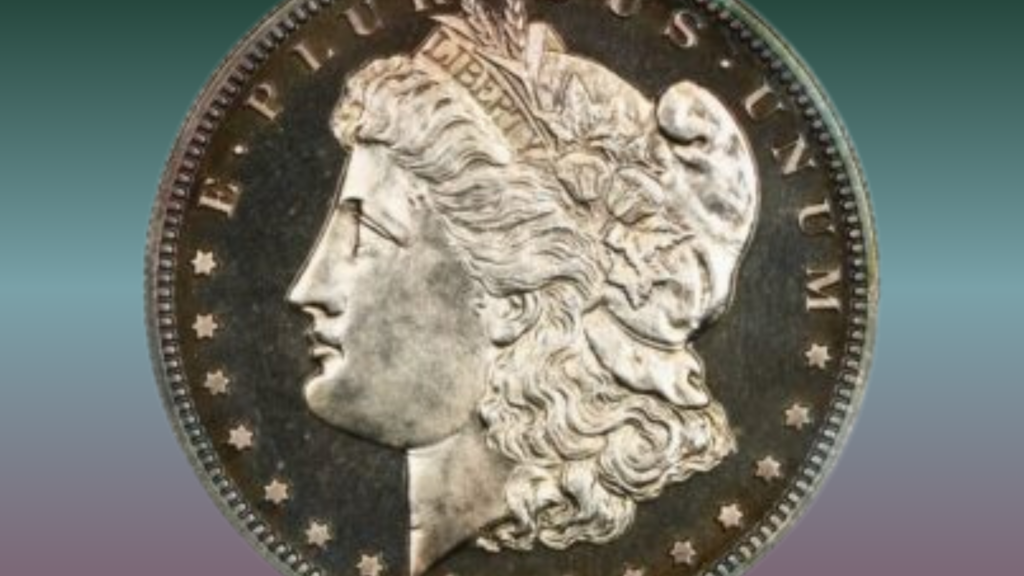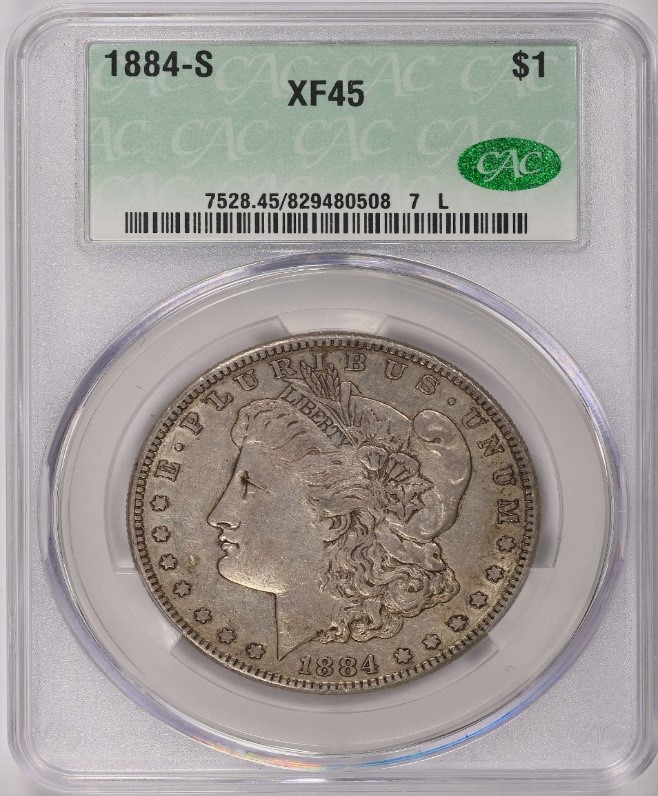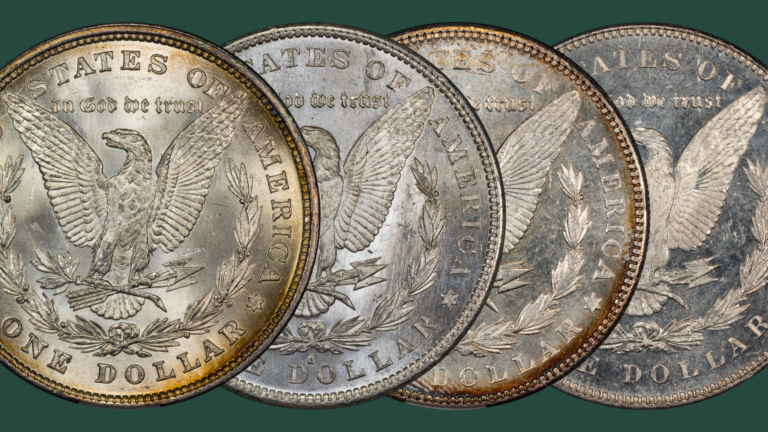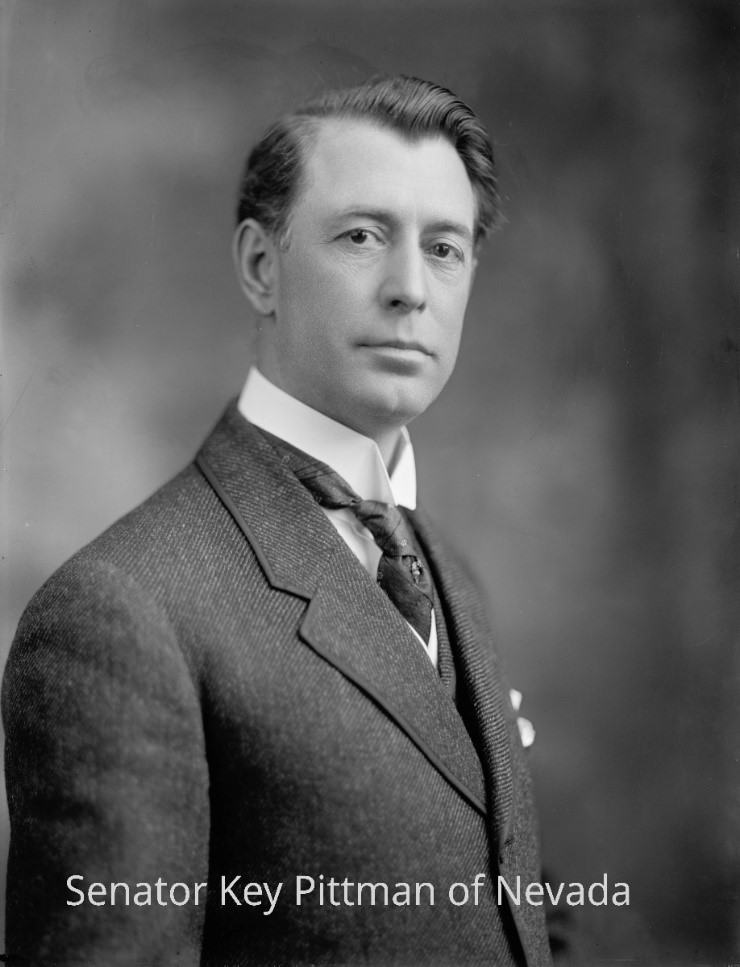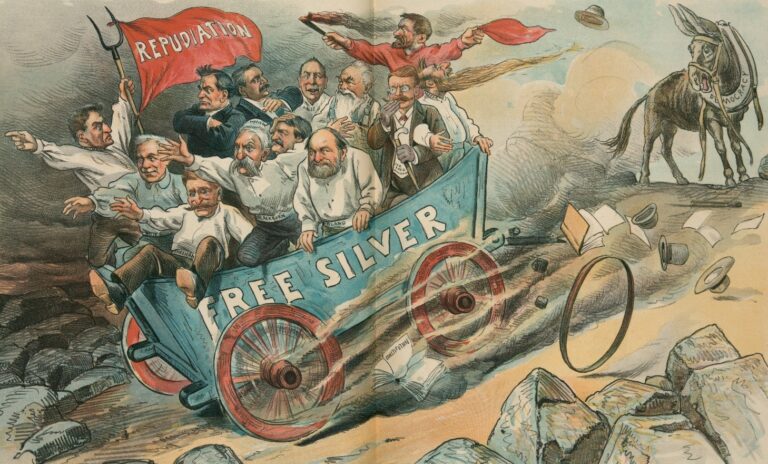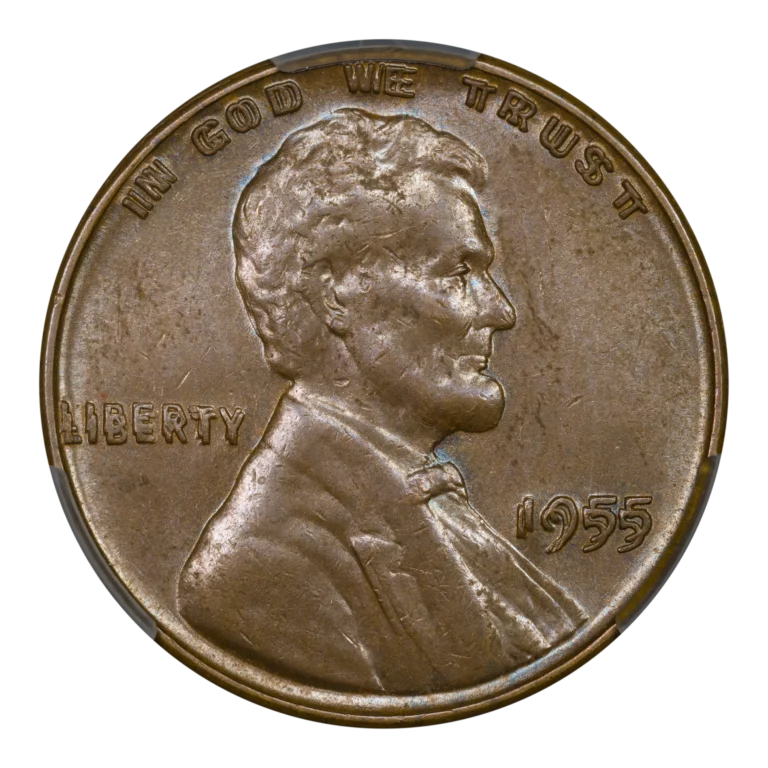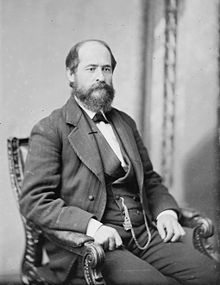by Greg Reynolds
Morgan silver dollars were minted from 1878 to 1904 and in 1921. Fantasy Morgan dollars to commemorate the real series, and its end in 1921, have been struck by the U.S. Mint beginning in 2021. It is easy to almost complete a set of Philadelphia Mint Proofs from 1878 to 1904 that are certified as grading in the 63 to -64 range.
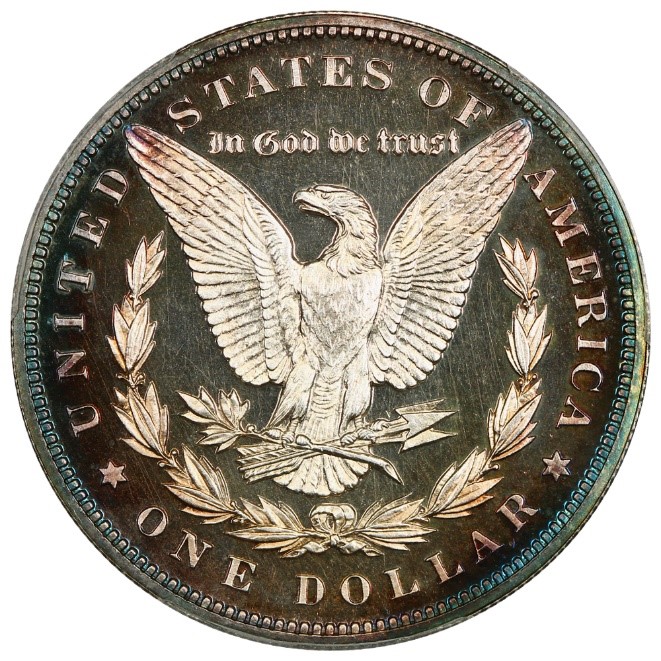
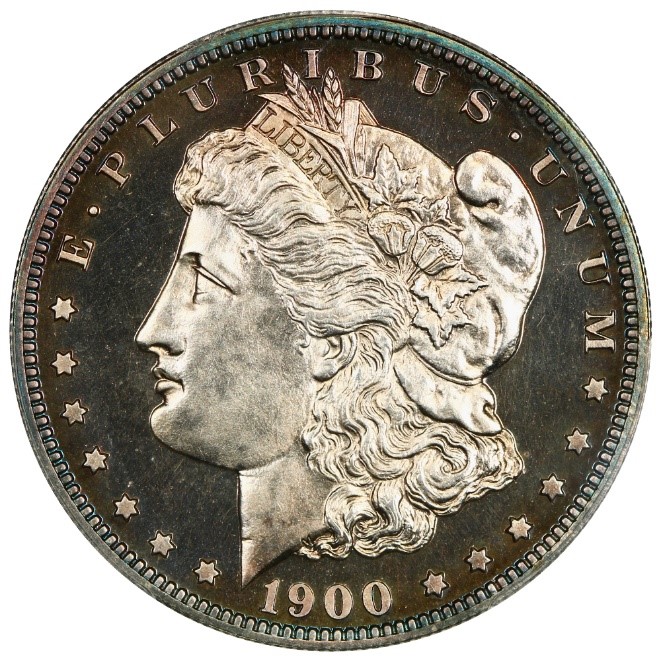
Most U.S. Proof coins minted before the end of World War II qualify for grades in the range of 61 to 68. There are some that circulated and thus should be graded below 60 and others that are ungradable because of serious problems. Surviving Proof silver coins dating from 1878 to 1904 are usually gradable.
Yes, it is true that there are Morgan silver dollars from the year 1921 that have been PCGS or NGC certified as Proofs. These are different in texture and manufacturing process from pre-1905 Proof Morgan dollars. Moreover, specially struck 1921 Morgans are expensive and command an explanation. Before thinking about non-Proof Special Strikings, certified Proof Morgans of 1921, or nineteenth century Branch Mint Proof silver dollars, it is a good idea for a beginning, casual or intermediate-level collector to focus on a set of Philadelphia Mint Proofs from 1878 to 1904.

Philadelphia Mint Proofs
These are rather consistent in physical format, color and striking characteristics. They were offered to the general public by the U.S. Treasury Department as Proof coins and were often sold to collectors who sought Proofs from 1878 to 1904. The primary U.S. Mint production facility was then and still is in Philadelphia. From the 1860s until 1915, many collectors, dealers and members of the general public acquired Proof sets or individual Proof coins directly from the Philadelphia Mint. Collectors obtained Proofs directly from the Philadelphia Mint before 1860, too, though in a somewhat secretive and/or informal manner.
Philadelphia Mint Proofs dating from 1878 to 1904 were widely understood in their own time and are widely recognized in the present. They are traded fairly often and are easy to sell.
Branch Mint Proof Morgan dollars are hard to explain and are a little complicated. Furthermore, San Francisco, Carson City (NV) or New Orleans Mint Morgan dollars that have been certified as Proofs or as non-Proof Special Strikings are very expensive. In my view, a few 1879-O Morgans are indisputably Proofs. A significant number of 1893-CC Morgans fulfill Proof criteria to the extent that it is certainly fair to categorize them as Proofs. I will comment on other mintmarked Morgans, which have been called Proofs, in the future. Most collectors of Proof Morgan dollars ignore Branch Mint Proofs.
In terms of design detail, relief of central devices, the relations of design elements to the fields, and other physical factors, even obviously Proof Philadelphia Mint Morgan dollars are not the best examples of Proof U.S. coinage. Microscopic details notwithstanding, Proof Morgans are often very attractive, and have been popular with collectors ever since Morgan dollars were introduced in 1878. Also, they are clearly different from business strikes, which are coins that were struck in a routine, regular, conventional or very rapid manner.
Perhaps the leading factor that separates a ‘Brilliant Proof’ from a business strike is the mirrorness of the fields. Of course, a coin can have mirrored fields and not be a Proof. Even so, Morgan dollars that were manufactured as Proofs by the Philadelphia Mint before 1905 tend to have thick and very glossy mirrored fields. The fields of Proof Morgans are different from the fields of prooflike Morgans, partly because prooflike Morgans are characterized by luster.
One of the strongest pieces of evidence that the Morgans that the U.S. Mint sold as Proofs really are Proofs in some physical and logical sense is that they tend to lack luster, meaning no luster is evident under 5x magnification. When a coin is struck, hot metal flows, to some extent in lines. Luster is the reflection of light by the effects or consequences of such metal flow on a coin. On a Proof coin, the treatment of the dies, preparation of the blanks (planchets), and power of the strike usually prevent a significant amount of luster from emerging or being apparent. Rich luster causes many uncirculated business strikes to be lively or animated.
Technical and scientific issues aside, there is little, if any, debate in the coin community concerning Philadelphia Mint Morgans dating from 1878 to 1904. Before grading services came into existence, Proof Morgans were actively traded and easily identified as such.
Strike Types, Proofs and Cameos for Morgan Dollars
There is a tremendous amount of agreement in regard to which Philadelphia Mint Morgan dollars are Proofs, which are prooflike business strikes which are regular business strikes. Prooflike Morgans have thinly reflective surfaces, and lack the glossy finish of Proofs. They have some of the pertinent characteristics of business strikes. It is wrong to refer to a business strike as a “circulation strike,” partly because there were millions of business strikes that were never really intended for circulation, including massive quantities of Morgan dollars, which are discussed in other articles of mine on the CACG site.
Among coins that are definitely Proofs, the presence, if any, of a ‘Cameo’ contrast is a factor that affects market value. A coin need not have a cameo contrast to be a Proof, though a substantial percentage of Proof U.S. coins feature a ‘Cameo’ contrast, at least partly. Many others had a ‘Cameo’ contrast a moment after being struck that has since faded, toned over or been lessened by mistreatment.
Proof or business strike, a coin is made when a prepared blank (planchet) is forcibly impacted by obverse (head) and reverse (tail) dies. The design elements on many Proof dies were coated or ‘burned’ with a chemical substance, sometimes containing an acid. There is more than one method to bring about a ‘cameo’ contrast. In regard to nineteenth century Proof Morgans, recessed areas on the dies that were so treated brought about, during the process of striking, design elements on coins with a relatively thick and/or rich white layer, sometimes with glitter.
The contrast between such white design elements and mirrored fields is ‘by tradition’ referred to as ‘Cameo.’ A deeper, more glaring or more vivid contrast may be referred to as ‘Ultra Cameo’ or ‘Deep Cameo.’ This contrast, however, may be artificially enhanced by dipping a coin in an acidic solution or by other means. I have never been an advocate of paying a large premium for a coin solely because it features a ‘Deep Cameo’ contrast. Indeed, many Proofs without ‘Cameo’ contrasts are more attractive than Proofs of the same type with ‘Cameo’ contrasts.
Purchasing a Proof Morgan as a Collector
Evidently, a large number of interested coin buyers are willing to pay substantial premiums for Morgan silver dollars and many other Proof coins with ‘Cameo’ contrasts, especially if so designated by CACG, NGC or PCGS. It is a fact, not an opinion, that coins with ‘Cameo’ or ‘Deep Cameo’ designations command noteworthy premiums, though it is an opinion as to whether a substantial premium should be paid. Collectors tend to make such decisions for themselves. A Proof coin that one collector finds to be marvelous may seem unimpressive to another collector of the same series.
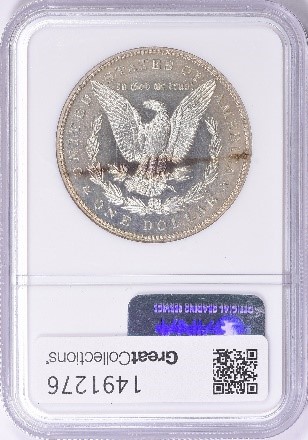
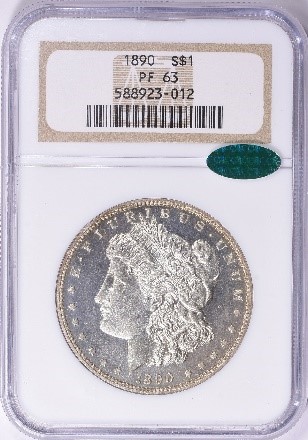
A purpose here is to provide useful information to collectors who are buying, wish to learn about or are willing to consider Proof Morgans. I am not recommending for or against the purchase of Proof Morgans in general, and I am not endorsing individual coins in this discussion.
As of March 4, 2024, the PCGS population of Proof Morgans was 10,075, including 1836 with “Cameo” designations and 272 with “Deep Cameo” designations. The total NGC census was 7798. More than a few dealers resubmit the same coins more than once, and not all of them return printed labels (‘inserts’) to the grading services after ‘cracking’ coins out of sealed plastic holders.
In total, perhaps 11,000 different Morgans have been PCGS or NGC certified as Proofs, more than 1500 of which have stickers of approval from CAC. These are rather small numbers in contrast to the total number of business strike Morgans that exist, as both PCGS and NGC have each graded millions of business strike Morgan silver dollars, literally!
As of March 4, 2024, the PCGS population of business strike Morgans was close to four million, including nearly 100,000 1882-S coins. The NGC census of business strike Morgans was also close to four million, 3,995,653. Even if the PCGS and NGC numbers represent just five million different business strike Morgans, Proofs are dramatically scarce in comparison.
CAC Approved Proof Morgans
CAC approved Proof Morgans are even scarcer, yet CAC approved Proof Morgans that are certified as grading 63 or 64 are not very difficult to find. Morgan silver dollars that are certified from Proof-60 to -62 tend to be unattractive, heavily cleaned, full of hairlines, overdipped, or irritating for other reasons. Occasionally, of course, a collector may find a very attractive Proof Morgan that is PCGS or NGC certified as Proof-61 or -62, with a CAC sticker. A wonderfully toned coin with some very noticeable scratches, for example, may grade 61.
Even though Proof-61 and -62 Morgans are usually not particularly attractive, it can be fun to collect them, especially by those who like completing sets at a relatively low cost or enjoy studying the scientific aspects of coins. Under a microscope, all nineteenth century coins appear very imperfect, though fascinate many science-minded collectors.
In regards to Proof Morgans that are PCGS or NGC certified at the same grade level, and CAC approved, the appearances of the coins often differ dramatically. Some may have many hairlines, while others may have very few hairlines that are noticeable under five-times magnifications. Some are very bright while others are very dark. Some Proofs have much deeper mirrors than others that were struck during the same year and have received the same grade from the same grading service.
I have found that I like CAC approved Proof-63 Morgans with deep natural toning. Further, I am fond of the deep, colorful natural toning that is often found on Proof U.S. silver coins from the 1860s to around 1910. Although I know that some collectors find deeply toned, never dipped Proofs to be ‘too dark,’ I suggest closely inspecting them as, in many instances, mellow or rich shades of green, orange, blue, apricot, red-russet and brown-russet may be appreciated. There are, however, collectors who like mildly or heavily dipped bright-white Proof Morgans.
Regardless of appearance, CAC approved, PCGS or NGC certified Philadelphia Mint Proof-63 Morgans dating from 1879 to 1904 had a CPG retail estimate of $4120 in March 2024. The 1894 and the 1895 are exceptions, as these are worth more.
Again except for the 1894 and 1895, for nineteenth century dates, the CPG-CAC retail price estimate for a certified Proof-63-Cameo Morgan is $4950. As CAC approved Proof-63-Cameo twentieth century Morgans are so rarely seen, it is probably best to just buy those without ‘Cameo’ designations or it may be practical for a collector focusing on Proof-63 Morgans to consider CAC approved Proof-64 Morgans dating from 1900 to 1904. It is often a good idea for a collector to be somewhat flexible while completing sets of classic U.S. coins.

Show off Your Collection in the CAC Registry!
Have CAC coins of your own? If so, check out the CAC Registry–the free online platform to track your coin inventory, showcase your coins by building public sets, and compete with like-minded collectors!
CAC Approved Morgan Proof Sales
On Dec. 10, 2023, GreatCollections sold a CAC approved, NGC certified Proof-63 1890 for $3417.22. On Nov. 19, 2023, GreatCollections sold a CAC approved, PCGS certified Proof-63 1885 for $3766.40. Though neither was designated as ‘Cameo,’ both this 1885 and this 1890 Morgan feature some ‘cameo’ contrast. A collector could obtain a coin with a noticeable ‘cameo’ effect without paying as much as the same coin would cost if it had a ‘Cameo’ designation from CACG, NGC or PCGS.
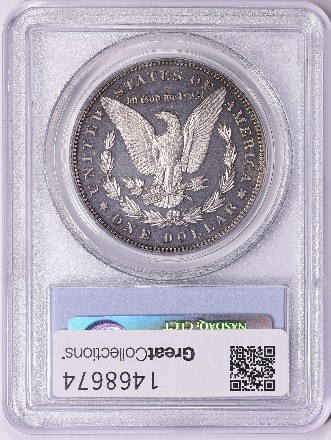
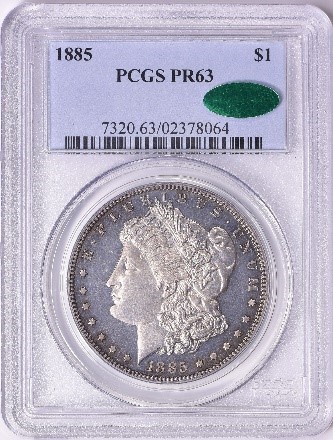
In March 2024, for Morgans dating from 1879 to 1899, except the 1894 and 1895, the CPG-CAC medium retail estimate for a Proof-64 coin was $5400 or $5650, and the CPG-CAC estimate for a CAC approved Proof-64-Cameo was $6600 or $6850.
Retail estimates are general figures and pertinent coins will sell for less or for more. On Feb. 4, 2024, DLRC sold a CAC approved, NGC certified Proof-64 1900 Morgan for $5000. On March 3, 2024, GreatCollections sold a CAC approved, PCGS certified Proof-64-Cameo 1899 dollar for $7250.10.
Because many dies were polished differently in the early 1900s, Proof Morgans dating from 1900 to 1903 with ‘Cameo’ designations tend to be worth substantially more than otherwise equivalent Morgan dollars from the nineteenth century. In regards to twentieth century Proof Morgans, it may be a good idea to pursue those without ‘Cameo’ designations.
On June 14, 2022, Stack’s Bowers auctioned a CAC approved Proof-64 1902 Morgan dollar for $5520. I find the central design elements on this coin to be cooler than those on many Proof-64 Morgans with ‘Cameo’ designations. The finish on this 1902 Morgan is reminiscent of the ghostlike finishes on the central devices of some Proof U.S. gold coins from 1901 to 1906, finishes which are not found on nineteenth century Proofs.
The Proof Morgan dollars of 1878 are scarcer than the Proofs of the 1880s. There are multiple widely recognized reverse varieties of 1878 Morgan dollars. Much attention is paid to the presence of seven tailfeathers rather than eight tailfeathers on the eagle. The tailfeathers are very small anyway. If the tailfeather varieties were not mentioned in price guides and other popular references, few collectors would notice whether an eagle has seven tailfeathers or eight tailfeathers.
Among reverse dies with seven tailfeathers, a distinction is made between dies from two reverse hubs, with minor differences of interest to few coin buyers. Beginners and casual collectors should figure that just one Proof 1878 Morgan is required for a set. Indeed, an 1878 with eight tailfeathers is sufficient to represent the year 1878. The collecting of coins by die pairing or even by noticeable die variety is different from completing a set ‘by date.’ A collector should first complete a set of Philadelphia Mint Proof Morgans, 1878-1904, by date before even thinking of expanding the set by adding die varieties. It may be fun to complete a set of Proof Morgans ‘by date’ and then ‘move on’ to another realm, like Proof Barber half dollars or Liberty Seated quarters.
The 1894 and the 1895 are needed for a set of Proof Morgans ‘by date.’ The 1894 generally commands a modest premium.
As of March 11, 2024, years have passed since a CAC approved Proof-63 to -64 1894 dollar has been sold at auction. Pre-pandemic prices realized are often well below market levels for silver dollars that prevailed from 2021 to 2023.
CAC has approved nine 1894 Morgans as Proof-63, two as Proof-63-Cam, two as Proof-63-DCam, nine as Proof-64, eight as Pr-64-Cam and zero as Pr-64-DCam. The CPG-CAC retail estimates for these in March 2024 might be too low. I would not count on being able to buy a Proof-63 1894 for $4250 or even for less than $5000. The CPG-CAC retail estimate of $5400 for a Pr-63-Cam 1894 is also likely to be too low. The CPG-CAC retail estimate of $8550 for a CAC approved Pr-64-Cam 1894 may be fairly accurate.
In March 2024, the CPG estimated value of an 1884 was that of a ‘common date’ Proof Morgan. The CPG-CAC retail estimate for a Proof-63 1884 is $4120 and the estimated value of a Proof-64 1884 is $5400. Yes, those with ‘Cam’ or ‘DC’ designations are worth more, though that is beside the immediate point. The CPG-CAC retail value estimate for a Proof-63 1895 was $79,200 in March 2024 and $90,000 for a Proof-64 1895.
Proofs in a Morgan Dollar Business Strike Set
A large number of collectors have included or seek to include an 1895 Proof in a set of business strike Morgans, as no 1895 business strikes are known. This additional demand results in 1895 Morgans being the most expensive of any ‘date’ in a set of Proofs.
Contrary to the beliefs of many coin enthusiasts, a large number of Proof coins circulated. Over the years, most circulated Proof U.S. coins were melted, partly for aesthetic reasons, as the surfaces of Proof coins are far more sensitive to hits and scratches than the surfaces of business strikes. Regardless of how abraded or unsightly they became, Proof 1895 Morgans, Proof 1876 Three Dollar Gold pieces, and Proof 1841 quarter eagles ($2.5 gold coins) were pulled from circulation because there are no corresponding business strikes. These are keys or semi-keys to their respective series.
Images are courtesy of www.GreatCollections.com of Irvine CA and DLRC of Virginia Beach (www.davidlawrence.com).
Copyright © 2023 Greg Reynolds
About the Author
Greg is a professional numismatist and researcher, having written more than 775 articles published in ten different publications relating to coins, patterns, and medals. He has won awards for analyses, interpretation of rarity, historical research, and critiques. In 2002 and again in 2023, Reynolds was the sole winner of the Numismatic Literary Guild (NLG) award for “Best All-Around Portfolio”.
Greg has carefully examined thousands of truly rare and conditionally rare classic U.S. coins, including a majority of the most famous rarities. He is also an expert in British coins. He is available for private consultations.
Email: Insightful10@gmail.com
